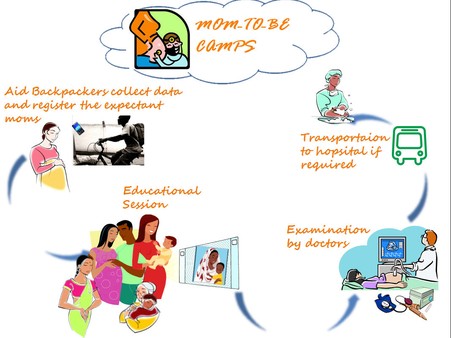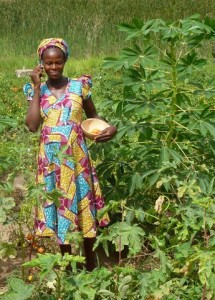Heather Thorne Matthews is the Director of Information and Communications Technology Innovation at the Grameen Foundation’s Technology Center.
The hut where I slept, and woke up to the sound of cows outside the door
I spent a weekend in early May with Simon Obwoya, one of Grameen Foundation’s Community Knowledge Workers, near Opit, Lalogi Subcounty, about 50km south-east of Gulu in Northern Uganda. Simon is 43, and is married, with 8 children, ranging from 6 months old to 19 years old. He and his family have 3 simple thatch-roof, mud brick huts in close proximity to their neighbors. They have no electricity, but have a bicycle, 2 cows, and about 5 acres of land (a lot compared to his neighbors) – although all plots are in separate locations within about 15-30 minutes’ walk from his hut. He speaks very good English.
While Simon seemed to be one of the better-off farmers in his village, his family can eat just 2 meals per day right now, cooks over a wood fire within a very smoky cooking hut, and their pit toilet collapsed, so they are building a new one and borrowing a neighbors’. In addition, his 19-year old daughter lost her baby about 3 weeks ago. All of these factors – food insecurity, whether or not a family has improved cookstoves, access to a latrine, and infant mortality – are indicators of extreme poverty as measured by Grameen Foundation’s Progress out of Poverty (PPI) Index, even though Simon and his family are lucky enough to have land and some livestock. The family was hoping to use Simon’s income from working as a Community Knowledge Worker and sales of ground nuts to send her back to school.
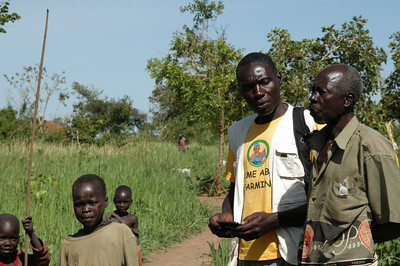
Simon surveying a local farmer
Simon is an active member of his local farming network, and uses his involvement there to promote the CKW program, and to register new farmers. He seemed to know everyone in his and the neighboring villages, and was well respected by his neighbors and peers, many of whom were registered farmers. When I first arrived, he took me around to introduce me to his family and immediate neighbors, and got me set up in one of the two sleeping huts that his family of 10 shares. I got an entire half, while 3 of his daughters slept on the other half. He was sensitive to the fact that I was probably not used to an entire village of children crowding into my bedroom, and must have requested they give me space, as there were numerous curious smiling little faces peering in the doorway and one window, but none dared to tread over the threshold.
Later that evening, we walked across the little-traveled dirt road to a neighboring village, which is near the old railroad which was abandoned by the government about 20 years ago when the violent insurgency led by Joseph Kony’s Lord’s Resistance Army began. Now that people are returning from the “security camps” to their land, and learning how to farm and take care of their families again, they are wishing for the railroad, which previously allowed them to travel to visit family, to sell goods at markets, etc. Today, they must walk, bicycle, or save their scarce funds to pay for a ride into town, where they can get better prices for their goods.
The next day was when I really began to understand the value that Simon and his fellow CKWs are bringing to their villages. As we walked around and met with different farmers, it became clear that there are some kinds of information that have extremely high value to farmers who are living on the border between being able to send their children to school or not…or in some cases, being able to feed their families or not. The most valuable kinds of information in this arable but very poor region included:
- When the rains were going to come, so farmers would know when to prepare their fields, and when to plant precious seeds (I saw many bean fields that were not germinating well, because the rains were late and farmers had rushed to plant, even though Simon had advised his farmers to wait based on the weather forecast he could access through his phone)
- What crops to plant based on harvest risk, pest/disease outbreaks, supply, etc. Almost every family I saw was planting beans and ground nuts (peanuts). Ground nuts, while earning high prices per acre planted, are very risky, as they can rot underground if the rains are too heavy. On the other hand, maize (corn) is an important staple crop for food security and feeding livestock, but I only saw one field of maize in all of our walks because prices per acre, when re-sold in the market, are low.
- Market prices. When farmers know what a crop is selling for in their local trading center, as well as the village 5km away, and the town 50km away, they know whether they should spend scarce resources on paying for transportation into town
- Improved seed varieties. Simon was able to point out when a farmer had planted an improved variety by looking at the leaves. Often, farmers do not know the potential value of paying a little more for those varieties in terms of yield, disease resistance, water usage, etc. If they can learn, from a trusted source, they may be more willing to plant these varieties
- Bulking – benefits of, how to find other farmers with whom to bulk. When farmers are growing very small quantities, they often cannot sell their crops for a good price or at all, because middlemen want to buy in larger volumes. In addition, programs like Purchase for Progress, by the World Food Program, require certain minimum volumes and quality in order to sell in. Providing a service that promotes the benefits of bulking, and connects farmers to other farmers (and to transport), helps close that loop.
- Post harvest handling and quality. Simon pointed out how he was teaching farmers to pick out bugs and beans that were too small, or of bad color, to ensure the farmers could obtain the best price for their crop.
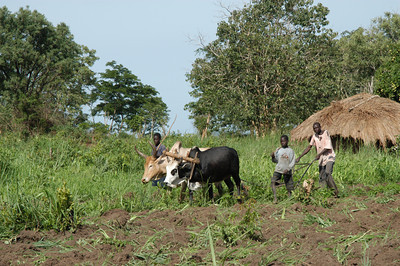
The only plow or tool I saw in use among all the farms we visited
I only saw one field being worked by a plow, and few to none of the farmers were using fertilizer. It was clear that having access to not only information, but appropriate financing or direct access to inputs, will be very valuable as well, in allowing farmers to increase their yields.
Another observation related to Simon’s work as a CKW is that while introducing an entirely new way to get actionable, relevant, local information to farmers where they need it, and having the ability to collect data in real-time through the phone, we must make the technology work so simply and seamlessly that it fades into the background. For example, poor battery life on Simon’s phone meant that we had to walk back 3km to his village after conducting a few surveys, even though there were 3 more farmers he would have liked to register and survey right in that same village. It was hot, dusty, and we wouldn’t be able to make another trip back that day. Grameen Foundation is looking for creative software and human solutions to minimize battery drain, extend battery life, and solve issues such as this one, but this was a good reminder that technology is only an enabler of the overall solution (and if not careful, it can become a barrier!)
I came away from my stay energized by the work the CKWs are doing, and really believing in the potential of this model. While we haven’t yet proven that the use of CKWs to extend the reach of traditional ag extension into the most remote villages can result in increased farmer yields and incomes, I believe that with deep collaboration with our extension partners, and with a focus on continuous improvement based on farmer and CKW feedback, we’ll get there.
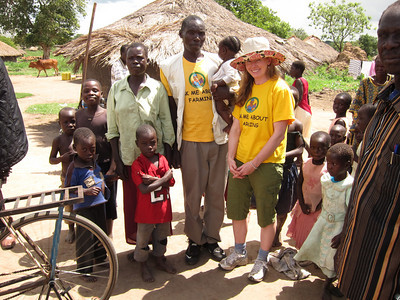
Simon and his family saying goodbye in front of their house
Simon and other CKWs like to describe their work as “volunteer” – because earning the respect of their peer farmers seems to be of most importance to them. At the same time, they are able to earn about $20/month (after paying back part of the cost of their phone and battery) for performing CKW services. For a farmer like Simon, this may almost double his family’s household income. He was hoping to use his income from CKW services and sales of ground nuts to send their 19-year-old daughter—the one who had lost her infant child—back to school. Maybe she’ll be the next CKW in her village… Or maybe she’ll go on to earn a degree and become Grameen Foundation’s next Gulu field officer… Keep her in school, and there’s no telling what is possible.




